By David Bowers
The snow may be blowing and the outside temperature hovering near zero, but you would never know that walking into the marine biology lab at Bellevue High School in Bellevue, Ohio. Walking in to this lab you are greeted with the subtle aroma of low tide and a marked increase in humidity, but Bellevue High School students quickly forget all of that as they are treated to the sight of an amazing 412g Indo Pacific Reef tank and 420g bamboo shark tank.
I am Dave Bowers and I took over the Marine program over 20 years ago. When I started we just had one 90 gal tank with some damsels and a snowflake eel jammed in the back corner of my classroom that I shared with another teacher.
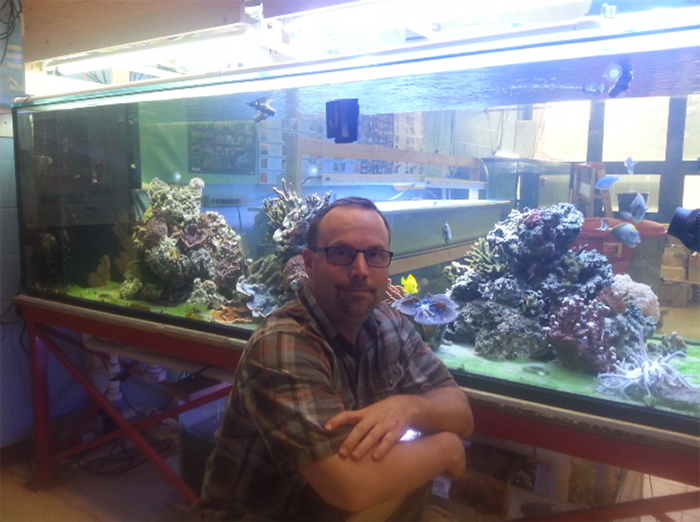
Photo by Dave Bowers.
Today the tanks are center stage and the hub of activity. Our program has evolved through the years, but the focus has always been the same: we are student-centric. My students decide how space is allocated and which projects they want to focus on. Five years ago the lab was full of small tanks housing pairs of Banggai cardinal fish (Pterapogon kauderni) and hovering students eagerly hoping to see fry in expecting fathers’ mouths. Today, our latest group of students are very interested in Hippocampus erectus seahorses and breeding ocellaris clowns.
Students take a great deal of pride in their lab and justifiably so. The students perform the majority of the cleaning, testing, monitoring, and all the other day to day chores it takes to maintain such a large and active lab room. In addition to the sps tank and shark tank, the students have clown breeding and fry tanks, seahorse and fry tanks, and of course two large 8′ long coral propagation tanks.
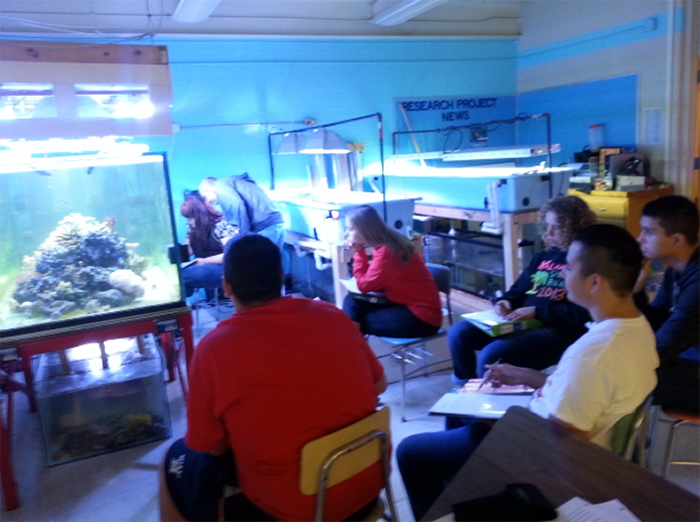
Photo by Dave Bowers.
I am frequently asked Why marine biology in land-locked Ohio? and to that I always say why not . I don’t mean that in a flippant way; It’s just that I realized very early on how much the students were drawn to that one tank in the corner. It sparked interest which sparks questions and after all; questions are what science is all about!
My students and I started rather humbly: There were about four or five students who though it would be neat to start a club. We worked together selling candy which raised some money and we bought a 220g acrylic tank and tried to start a model reef. We had real no clue what we were doing and made loads of mistakes. But we learned from our mistakes and were lucky enough to get help from local reef clubs to get us sorted out. That reef tank led to a string of smaller experimental tanks and the original handful of students mushroomed into a room full of eager to learn students. Our acrylic tank failed about 8 years ago and was replaced by a stunning 412 g Miracles in Glass display tank. The first attempt at reef keeping featured xenia and aiptasia in about equal amounts and supplemented with more hair algae than a whole school of tangs could have ever eaten. Today, the students are quite successfully growing all the stony corals of the Indo-Pacific. Fellow reef keepers are amazingly generous with their advice without which we would still be floundering in algae and pests. Despite the beauty of the stony coral display, the tank is first and foremost a teaching tool. Students harvest loads of coral frags for their various study projects or to observe polyps up-close under the microscope.
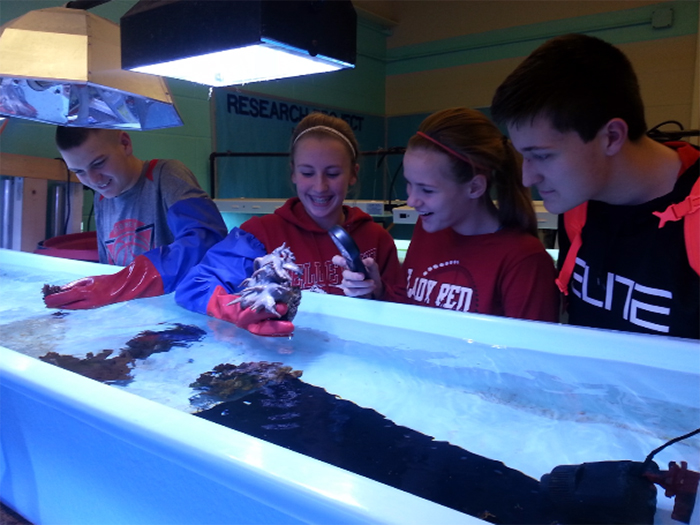
Photo by Dave Bowers.
Our students use our two 8′ long coral propagation bins to run most of their trials in. We also use those bins for quarantining any new fish before adding them to the display tank. The coral bins are the workhorses of our program. The tanks’ size and depth create stable yet economical to operate study and growth systems. We can add dividers to isolate corals from the main system for target feeding experiments and similar trials.
One of the students’ favorite tanks is our 60g breeder which houses a group of Hippocampus erectus seahorses. They are irregular breeders but we are still working hard to keep a working developmental tank ready for the next time one of the boys has babies. To date we have been able to keep fry alive for about 8 days after release from the father but not past that point yet. Our students are working on a drip feeding device that will keep the supply of live food to the fry coming without overwhelming filtration when we are not in the classroom.
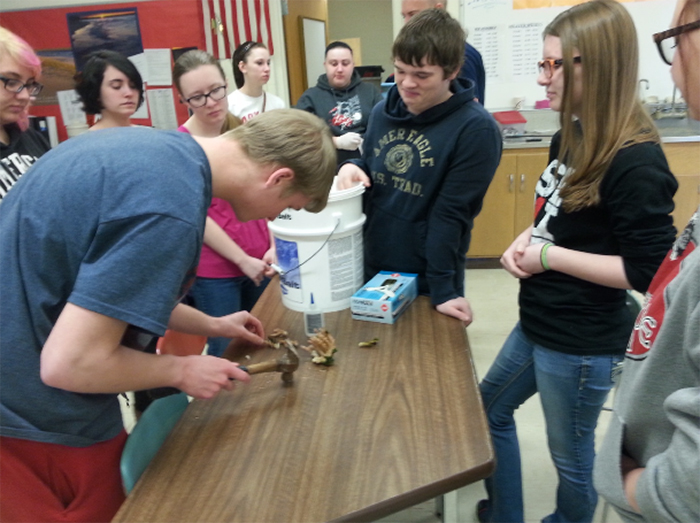
Photo by Dave Bowers.
Clownfish remain the most popular fish since the release of Nemo. We were very lucky in winning a pair of fancy tailed snowflake ocellaris which have recently begun producing fry. We are eager to work out a means of overcoming the same issues of not being able to feed the fry over night which seems to be our limiter to success.
The students involved in studies have a great deal of responsibility and high expectations. Long before any research is approved the students must pass basic skills in aquarium husbandry and research techniques. Students then conduct brief studies to determine the feasibility of being able to answer the questions they are hoping to investigate. Students are given the option of working as an independent study for course credit which entails them giving up their study hall period or non credit which limits what sorts of projects they can work on but also demands less of their time.
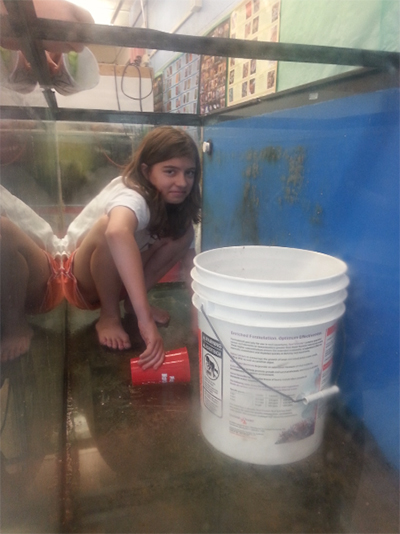
Photo by Dave Bowers.
Each year a student lab manager is elected. This is the toughest job in the lab. It falls to the manager to review the log books each day, visually inspect each tank for signs of troubles, and the manager usually sits in on each group’s research project meeting to understand how best to help that group with their equipment and livestock needs and care. Lab manager may be the toughest job but it is also a position of great honor. Past managers have gone on to win many academic scholarships and have been accepted into world class institutions such as the Marine Biology program at the University of Hawaii, the United States Naval Academy, Marine Biology at Bowling Green State University, and many other programs around the country.
Two of the many stand outs from our program are recent co-managers Emily Schaffer and Emily Wallingford. These two stellar young ladies and their dads drove from Bellevue, Ohio down to the Tennessee Aquarium to collect two bamboo sharks. The following school year the two young ladies studied stress levels of the captive sharks by means of collecting their fecal pellets and using the laboratory facilities at the University of Toledo Medical Campus to separate hormones. Working with the assistance of Dr. John Turner, the two high school students discovered a yet to be described hormone which is a cousin to the stress-response hormone cortisol. Considerable future work would need to be done before correlations between elevated levels of this newly discovered hormone and elevated stress can be stated. Emily Wallingford is finishing up her undergraduate program at the University of Hawaii at Hilo while Emily Schaffer is busy at BYU studying acting.
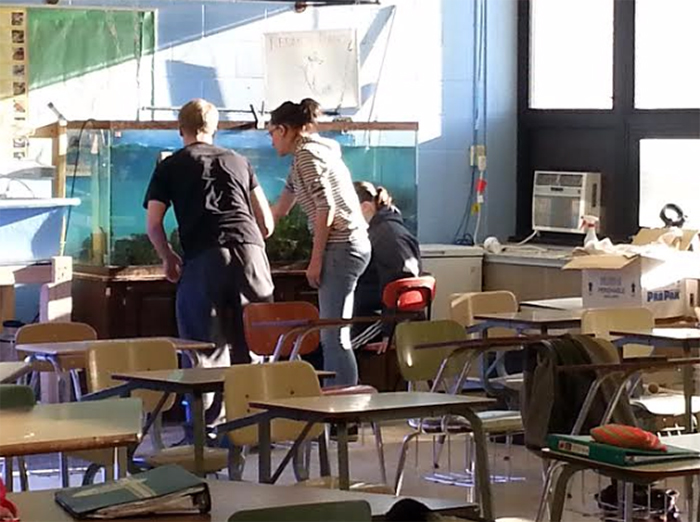
Photo by Dave Bowers.
Twenty years later students still come into my lab and head straight to the tanks. And even more amazingly they still surprise me with such great and insightful questions that never occurred to me before. It has been a real blessing to be a part of such a wonderful program and I genuinely feel honored to be able to work with such bright young minds.
We owe so much of who we are today to the local reef clubs; in particular the Central Ohio Reef Aquarists (CORA) who are an outstanding group of folks, the support they students immensely. They are very generous with their knowledge, spare parts, and help us with special buys of salts etc. Recently we have had the good luck of getting a donation for Larry DuPont of LRS fish foods. Larry and his wife sent us several packages of their best foods. As did Ohio based fish food maker Skipper Steve. Polyp Lab recently approached us to sponsor one of our coral research bins and sent us their sps coral product line up.
Since the program is completely self-funded, the support of clubs, companies, and generous individuals have had a tremendous impact on the program. Without their help the students could not continue their studies and coming up with all new questions to explore.
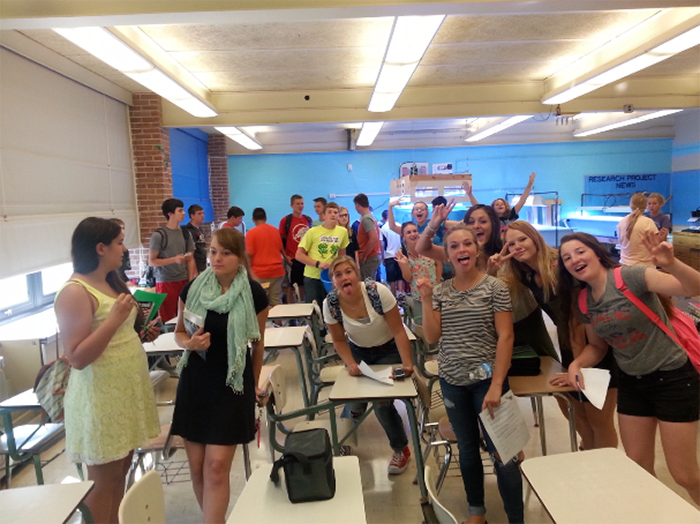
Photo by Dave Bowers.
Would you like to help out? Here is how: the program goes through salt and light bulbs like… well it takes a great deal of money for both of those. A monetary donation can be made to the program Contact [email protected]
Would you like to see one of your corals in their big display: send them a frag: The students are big fans of the colored sticks and zoanthids. Their system is not well suited for most of the soft corals or corals with exceptionally long sweepers or are chemically aggressive in protecting their turf. Live Stock donations can be made by contacting David Bowers at [email protected]
Be sure to follow the Bellevue High School Mhttps://www.facebook.com/Bellevue-High-School-Marine-Science-Club-



0 Comments